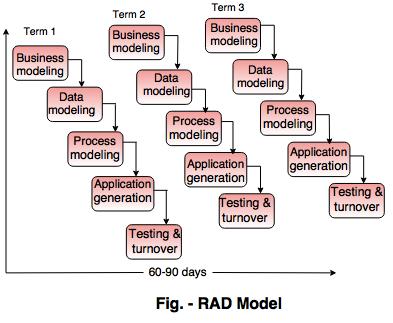Prescriptive Process Models
The following framework activities are carried out irrespective of the process model chosen by the organization.
1. Communication
2. Planning
3. Modeling
4. Construction
5. Deployment
The name 'prescriptive' is given because the model prescribes a set of activities, actions, tasks, quality assurance and change the mechanism for every project.
There are three types of prescriptive process models. They are:
1. The Waterfall Model
2. Incremental Process model
3. RAD model
1. The Waterfall Model
- The waterfall model is also called as 'Linear sequential model' or 'Classic life cycle model'.
- In this model, each phase is fully completed before the beginning of the next phase.
- This model is used for the small projects.
- In this model, feedback is taken after each phase to ensure that the project is on the right path.
- Testing part starts only after the development is complete.
 NOTE:
NOTE: The description of the phases of the waterfall model is same as that of the process model.
An alternative design for 'linear sequential model' is as follows:
 Advantages of waterfall model
Advantages of waterfall model- The waterfall model is simple and easy to understand, implement, and use.
- All the requirements are known at the beginning of the project, hence it is easy to manage.
- It avoids overlapping of phases because each phase is completed at once.
- This model works for small projects because the requirements are understood very well.
- This model is preferred for those projects where the quality is more important as compared to the cost of the project.
Disadvantages of the waterfall model- This model is not good for complex and object oriented projects.
- It is a poor model for long projects.
- The problems with this model are uncovered, until the software testing.
- The amount of risk is high.
2. Incremental Process model
- The incremental model combines the elements of waterfall model and they are applied in an iterative fashion.
- The first increment in this model is generally a core product.
- Each increment builds the product and submits it to the customer for any suggested modifications.
- The next increment implements on the customer's suggestions and add additional requirements in the previous increment.
- This process is repeated until the product is finished.
For example, the word-processing software is developed using the incremental model.
 Advantages of incremental model
Advantages of incremental model- This model is flexible because the cost of development is low and initial product delivery is faster.
- It is easier to test and debug during the smaller iteration.
- The working software generates quickly and early during the software life cycle.
- The customers can respond to its functionalities after every increment.
Disadvantages of the incremental model- The cost of the final product may cross the cost estimated initially.
- This model requires a very clear and complete planning.
- The planning of design is required before the whole system is broken into small increments.
- The demands of customer for the additional functionalities after every increment causes problem during the system architecture.
3. RAD model
- RAD is a Rapid Application Development model.
- Using the RAD model, software product is developed in a short period of time.
- The initial activity starts with the communication between customer and developer.
- Planning depends upon the initial requirements and then the requirements are divided into groups.
- Planning is more important to work together on different modules.
The RAD model consist of following phases:
1. Business Modeling- Business modeling consist of the flow of information between various functions in the project.
- For example what type of information is produced by every function and which are the functions to handle that information.
- A complete business analysis should be performed to get the essential business information.
2. Data modeling- The information in the business modeling phase is refined into the set of objects and it is essential for the business.
- The attributes of each object are identified and define the relationship between objects.
3. Process modeling- The data objects defined in the data modeling phase are changed to fulfil the information flow to implement the business model.
- The process description is created for adding, modifying, deleting or retrieving a data object.
4. Application generation- In the application generation phase, the actual system is built.
- To construct the software the automated tools are used.
5. Testing and turnover- The prototypes are independently tested after each iteration so that the overall testing time is reduced.
- The data flow and the interfaces between all the components are are fully tested. Hence, most of the programming components are already tested.




